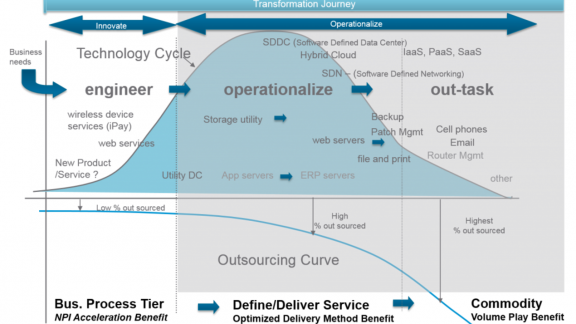Traditionally, IT commodity services and products have the highest percentage of being outsourced in our industry. There is a belief among a majority of people in our industry that IT commoditization is a very bad thing.
In its simplest form, a company’s success is measured by its capability to produce a product or service efficiently and to meet the market demand for that product or service. Running IT as a business implies that we need to also do the same for our internal customers by providing products and services cost effectively with repeat-ability and predictability at an agreed cost. IT organizations are viewed as a business enabler and trusted advisor by getting out of the business of building and running commodity IT products and services and focusing on providing the business with resources that provide new product capabilities and business differentiators in their market.
We need to understand what a commodity is in order to change how IT is run and provide that business focus.
A commodity starts as any thing that has a perceived value by a consumer. A more common understanding of a commodity is a product that is generic in nature and has the same basic value as all similar items. (a simplified example is a Server)
For example, virtualized hardware, in the IT data center context, is a device or device component that is relatively inexpensive, widely available and more or less interchangeable with other hardware of its type.
By definition, a commodity product lacks a unique selling point. In an IT context, the term usually differentiates typical IT products from specialized or high-performance products. A commodity, when looked at this way, is a low-end but functional product without distinctive features. Generally, as hardware moves along the technology cycle, that hardware becomes a commodity as the technologically matures in that marketplace. That implies that most hardware products, like network switches, that have been around for a long time are now available in commodity versions, although they aren’t generally marketed as such. In the past, physical networking infrastructure was viewed as specialized until the maturity of virtualization of this layer of technology became available and more widely spread.

Lets look at a more traditional commodity example, the local gas station. The gas at your pump is the same as the gas at any of the other pumps. It’s also the same as the gas at the station across the street or across town. There may be a very slight change in price, but the products essentially sell for the same basic price and are the same regardless where they are purchased. Can your consumers of IT products and services get this same consistency? Are we trying to refine our own gas before providing it to our consumers?
When we compare this scenario to a traditional IT organization we need to ask ourselves, what commodity areas are we focusing on reinventing and providing. From the IT standpoint, can we virtualize our hardware environment and reap some of the benefits like “FASTER TIME TO MARKET”, “COST EFFECTIVENESS” and “IMPROVED QUALITY”. Are we already doing this and can we drive further up the technology curve build and/or broker services and products such as IaaS, PaaS or SaaS to drive faster business value?
Our common fear is that “Commodity IT” implies low quality and cost or that our roles will be outsourced. In comparison, a commodity product or service is not sold cheaper that it takes to produce or run it. Like wise a commodity IT product or service should have affordability, repeat-ability and predictability in delivery and as brokers not builders, IT organizations can provide this service to the business.
In summary, studies have shown that IT organizations focus a lot of effort and resources on building and running products and services at the back end of the transformation curve. This is the area with the least amount of business value but consumes a majority of IT time & resources. IT organizations need to shift focus to the front of the technology cycle and help the business create and engineer new products and services that drive revenue.
IT best practices exist to help IT organizations move to the front of the technology cycle by reorganizing people, process and technology to use the building blocks of various commodity products and services to provide affordable, repeatable and predictable services. This allows IT organizations to focus on the front of the curve. Now that’s a lot more valuable and fun.
Commodity IT – It’s a great thing for everyone!
=========
Les Viszlai is a principal strategist with VMware Advisory Services based in Atlanta, GA.





